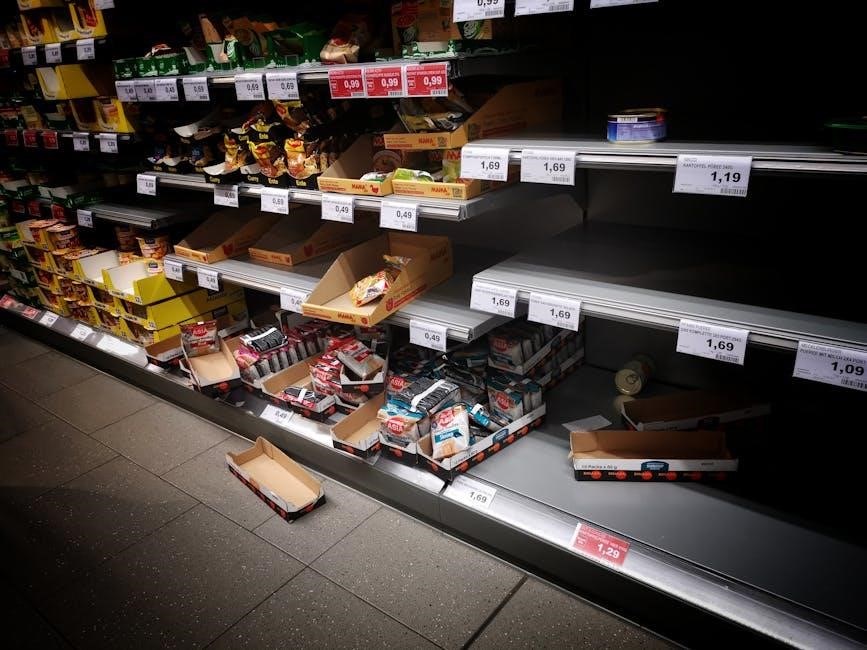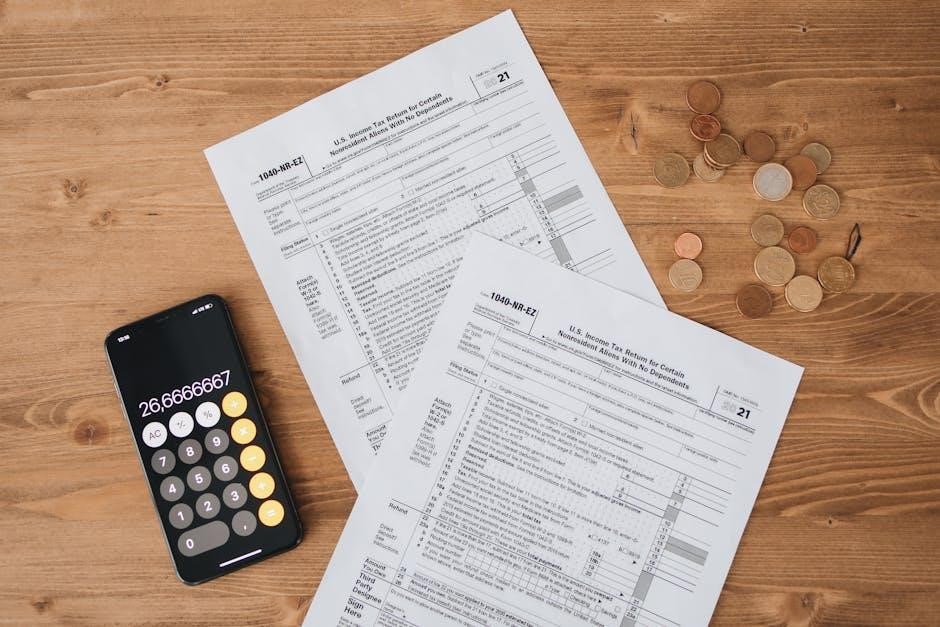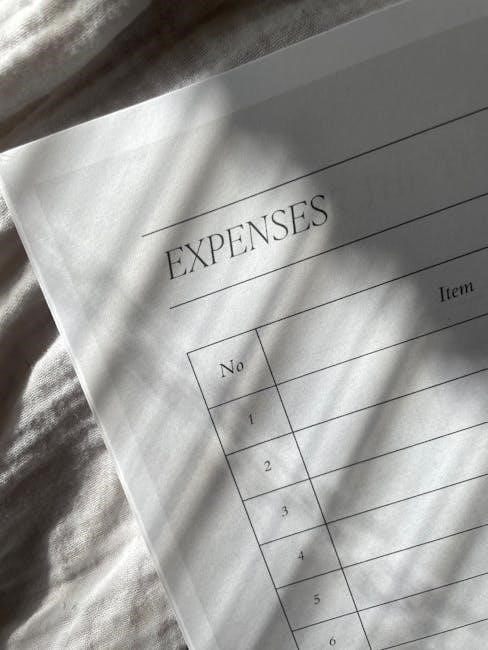This worksheet explores key concepts in supply economics, including the law of supply, factors affecting supply, and equilibrium. It provides practical exercises to master these principles.
Overview of the Worksheet
This worksheet is a comprehensive resource designed to help students understand and apply supply economics concepts. It includes multiple-choice questions, case studies, and graphical analyses to reinforce learning. The exercises cover topics such as the law of supply, factors affecting supply, and equilibrium. Additionally, the worksheet provides solutions in PDF format, making it easier for students to review and compare their answers. The structured format ensures a systematic approach to mastering supply economics, with clear explanations and examples. It is an ideal tool for both independent study and classroom use, offering a detailed yet accessible way to grasp complex economic principles.
Importance of Understanding Supply Economics
Understanding supply economics is crucial for analyzing market dynamics and making informed decisions. It helps explain how producers respond to price changes and external factors, shaping market outcomes. By grasping these concepts, students can better comprehend the forces driving resource allocation and production decisions. This knowledge is essential for evaluating real-world economic scenarios, such as how new technologies or government policies influence supply. Mastery of supply economics also enhances critical thinking and problem-solving skills, preparing students for careers in business, policy, and academia. The worksheet provides practical exercises to deepen this understanding, ensuring a solid foundation in economic principles.

Key Concepts in Supply Economics
This section covers foundational ideas like supply definition, the law of supply, and factors influencing it. It also explores elasticity and market structures affecting supply dynamics.
Definition of Supply
Supply refers to the total amount of a good or service that producers are willing and able to sell at a given price level during a specific time period. It is a fundamental concept in economics, representing the market’s capacity to provide goods and services. The supply of a product is determined by factors such as production costs, technology, and expectations about future prices. Understanding supply is crucial as it, along with demand, determines market equilibrium. Producers adjust supply based on price changes and market conditions, aiming to maximize profits while meeting consumer needs effectively.
The Law of Supply
The Law of Supply states that, all else being equal, the quantity of a good or service supplied increases as its price rises; Producers are incentivized to produce more when prices are higher, as it becomes more profitable. This direct relationship between price and quantity supplied is a cornerstone of supply economics. The law assumes factors like production costs, technology, and expectations remain constant. Graphically, the supply curve slopes upward, illustrating this principle. Understanding the Law of Supply is essential for analyzing how markets respond to price changes and how equilibrium is achieved in various economic scenarios.

Factors Affecting Supply
Supply is influenced by the price of the good, production costs, technology, expectations, and the number of sellers. These factors shape producers’ supply decisions and market dynamics.
Price of the Good
The price of the good is a primary factor influencing supply. As the price of a product increases, suppliers are incentivized to produce more to maximize profits. This direct relationship is a fundamental aspect of the law of supply. When prices rise, producers expect higher revenues, encouraging them to expand production. Conversely, if prices fall, suppliers may reduce output to avoid losses. This price responsiveness is a key driver of market dynamics, as it directly impacts the quantity supplied. Understanding this relationship is crucial for analyzing how supply adjusts to price changes in various market scenarios.
Cost of Production
Cost of production is a critical factor influencing supply. As production costs increase, producers face higher expenses, which can reduce profitability. This often leads to a decrease in supply, as producing the same quantity becomes less economical. Conversely, if production costs decline, suppliers can produce more at lower expense, increasing supply. Changes in input prices, such as labor, materials, or technology, directly impact production costs. Producers constantly seek to minimize these costs to maximize efficiency and maintain competitiveness. Understanding the relationship between production costs and supply is essential for analyzing market behavior and decision-making in supply economics.
Technology
Technological advancements significantly impact supply by altering production methods and efficiency. Improved technology can reduce production costs, increase output, and enhance product quality. For instance, automation and machinery enable firms to produce more with fewer resources, lowering costs and increasing supply. Additionally, technology can create new production possibilities, expanding the range of goods and services available. Investments in research and development often lead to innovative solutions, further boosting supply capabilities. As technology evolves, suppliers can adjust their output to meet market demands more effectively, driving economic growth and competitiveness in various industries.
Expectations
Expectations about future market conditions significantly influence supply decisions. Producers adjust their current output based on anticipated price changes, production costs, and demand. If businesses expect prices to rise, they may reduce supply now to sell later at higher prices. Conversely, if prices are expected to fall, producers might increase current supply to avoid future losses. Similarly, expectations about future costs or technological advancements can alter production plans. Changes in consumer demand forecasts also play a role, as firms may increase or decrease supply to meet anticipated needs. These expectations can shift the supply curve, impacting market equilibrium and resource allocation.
Number of Sellers
The number of sellers in a market directly impacts the supply of a good or service. When more firms enter a market, the total supply increases, shifting the supply curve to the right. Conversely, if sellers exit the market, supply decreases, shifting the curve to the left. The ease of entry and exit depends on market structure and barriers to entry. In competitive markets, new firms can enter easily, increasing supply. In markets with high barriers, such as monopolies, fewer sellers result in lower supply. This dynamic influences market equilibrium and the allocation of resources.

Supply and Demand Equilibrium
Supply and demand equilibrium occurs where supply equals demand, determining market price and quantity. Shifts in supply or demand alter equilibrium points.
Equilibrium Price and Quantity
Equilibrium price and quantity occur where the supply and demand curves intersect. At this point, the quantity suppliers are willing to sell equals the quantity buyers are willing to buy. Changes in supply or demand shift the equilibrium, altering market outcomes. For example, an increase in demand raises the equilibrium price and quantity, while a decrease in supply has the same effect. Understanding equilibrium helps analyze how market forces allocate resources efficiently. Graphically, it is the point where the supply schedule and demand schedule meet, ensuring no surplus or shortage in the market.

Shifts in Supply and Demand Curves
Shifts in supply and demand curves occur when factors other than price affect the quantity supplied or demanded. For supply, changes in production costs, technology, or expectations can shift the curve. For demand, factors like income, preferences, or prices of related goods cause shifts. A shift in supply changes the equilibrium without altering demand, while a demand shift does the opposite; These shifts help explain market dynamics, such as how external events influence prices and quantities. Understanding shifts is crucial for analyzing real-world market behavior and predicting how variables interact to shape economic outcomes.

Elasticity of Supply
Elasticity of supply measures how responsive the quantity supplied is to price changes. It depends on production costs, technology, and time frames, influencing market adjustments.
Price Elasticity of Supply
Price elasticity of supply (PES) measures the responsiveness of quantity supplied to changes in price. It is calculated as the percentage change in quantity supplied divided by the percentage change in price. A PES greater than 1 indicates elastic supply, meaning quantity supplied changes significantly with price. If PES is less than 1, supply is inelastic, showing little response to price changes. Elasticity depends on factors like production costs, technology, and time. Understanding PES helps producers and policymakers predict market behaviors, making it crucial for supply economics analysis. This concept is vital for optimizing production and pricing strategies in various market scenarios.
Determinants of Elasticity

The elasticity of supply is influenced by several factors. Resource availability and production costs play a significant role; if inputs are scarce or costly, supply becomes less elastic. Technological advancements can increase elasticity by making production more flexible. Time is another key determinant—short-term supply is often inelastic, while long-term supply can adjust more readily. Market expectations and the number of suppliers also affect elasticity, as more sellers may respond more quickly to price changes. Understanding these determinants helps in analyzing how supply responds to market conditions, making them essential for economic forecasting and decision-making in supply economics.

Government Intervention in Supply
Government policies, such as taxes, subsidies, and price controls, significantly influence supply. These interventions aim to stabilize markets or redistribute income, affecting producers’ incentives and production levels.
Taxes and Subsidies
Taxes and subsidies are key tools of government intervention in supply. Taxes on production increase costs, reducing supply, while subsidies lower costs, encouraging production. Taxes shift the supply curve left, whereas subsidies shift it right. Both policies aim to correct market failures or redistribute resources. For instance, environmental taxes may reduce harmful production, while agricultural subsidies ensure food security. Understanding these mechanisms is crucial for analyzing how government policies alter market outcomes and producer behavior in supply economics.
Price Ceilings and Floors
Price ceilings and floors are government interventions that influence supply dynamics. A price ceiling sets a maximum price producers can charge, often leading to shortages as supply decreases. Conversely, a price floor establishes a minimum price, typically causing surpluses as supply exceeds demand. These policies aim to protect consumers or producers but often distort market equilibrium. For example, rent ceilings may lower housing supply, while agricultural price floors can lead to excess production. Understanding these interventions is vital for analyzing how government policies alter market outcomes and affect producer incentives in supply economics.

Market Structures and Supply
Market structures like perfect competition and monopoly influence supply dynamics. Perfect competition ensures efficient supply allocation, while monopoly can lead to restricted supply and higher prices.
Perfect Competition
In a perfectly competitive market, firms operate as price takers, meaning they accept market prices rather than setting them. This structure ensures efficient supply allocation, as firms produce at the lowest cost. With free entry and exit, resources are allocated based on market demand. Homogeneous products and perfect information characterize this market, leading to optimal output levels. Supply decisions are solely based on market prices, eliminating monopolistic practices. Perfect competition maximizes social welfare by ensuring producers supply exactly what consumers demand at the lowest possible cost, creating a balanced and efficient market structure.
Monopoly
In a monopoly, a single firm is the sole supplier of a product with no close substitutes. This market structure grants the firm significant pricing power, allowing it to influence supply and prices. Barriers to entry, such as patents or high startup costs, prevent competition. Monopolists maximize profits by equating marginal cost to marginal revenue, often resulting in higher prices and lower output compared to competitive markets. Supply decisions are strategically made to maintain market dominance, contrasting with the competitive market’s efficient allocation. This structure highlights the imbalance of power between producers and consumers in supply economics.

Practice Problems and Solutions
This section provides practice problems and solutions to help students apply supply economics concepts. Exercises cover supply curves, elasticity, and market structures, reinforcing key concepts effectively.
Case Studies
Case studies in supply economics provide real-world applications of theoretical concepts. For example, analyzing how shifts in supply impact agricultural markets or how technology advancements affect production costs. These studies help students understand how firms respond to changes in demand, production costs, or government policies. A case study on a monopolistic market illustrates how a single supplier influences prices and output. Another example examines the effects of subsidies on supply curves in the energy sector. By evaluating these scenarios, students gain practical insights into supply dynamics and market structures, enhancing their ability to analyze and predict economic outcomes accurately.
Common Mistakes to Avoid
When studying supply economics, common mistakes include confusing supply and demand shifts, misinterpreting elasticity calculations, and overlooking the impact of external factors like taxes or subsidies. Students often miscalculate equilibrium points or fail to consider how technology advancements affect production costs. Additionally, neglecting to distinguish between inelastic and elastic supply scenarios can lead to incorrect conclusions. It’s crucial to carefully analyze shifts versus movements along supply curves and avoid assuming all markets function under perfect competition. Recognizing these errors early enhances understanding and prevents misapplication of key concepts in supply economics. Always double-check assumptions and calculations to ensure accuracy.
Mastering supply economics requires understanding key concepts like supply, demand equilibrium, and elasticity. Regular practice and real-world applications solidify comprehension, ensuring economic decisions are data-driven and informed. This concludes Chapter 5.
Chapter 5 focuses on supply economics, emphasizing the law of supply and factors influencing it, such as price, production costs, technology, and seller expectations. Understanding supply-demand equilibrium is crucial for determining market prices and quantities. Elasticity of supply measures responsiveness to price changes, shaped by production flexibility and resource availability. Government interventions, like taxes and subsidies, alter supply dynamics. Different market structures, such as perfect competition and monopoly, affect supply behavior. Mastery of these concepts enables accurate analysis of market mechanisms and informed decision-making in economic scenarios.
Final Tips for Mastering Supply Economics
To excel in supply economics, regularly practice analyzing supply curves and shifts. Focus on understanding how price elasticity impacts supply decisions. Apply theoretical concepts to real-world markets to reinforce learning. Stay updated on current events that influence supply, such as technological advancements or policy changes. Review key formulas and graphs, like supply-demand equilibrium models. Engage in discussions or study groups to clarify doubts. Lastly, attempt practice problems from various sources to build problem-solving skills. Consistent effort and practical application will enhance your mastery of supply economics concepts.

Leave a Reply
You must be logged in to post a comment.